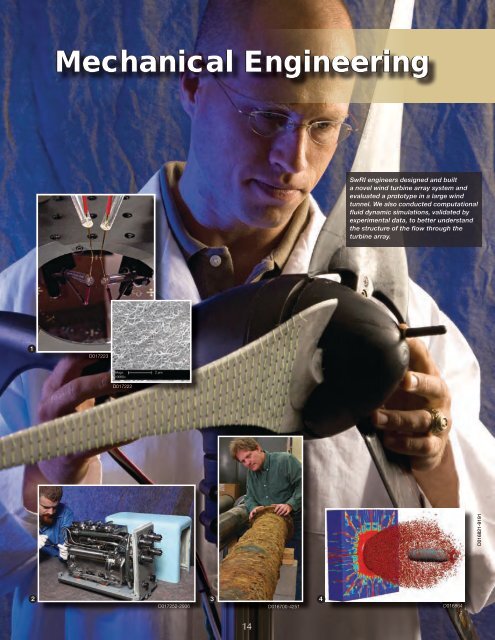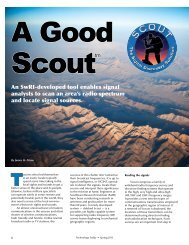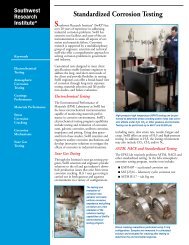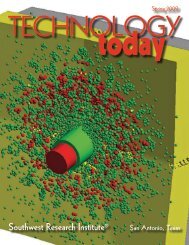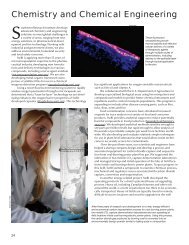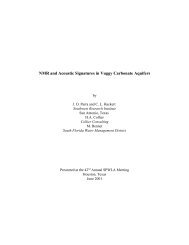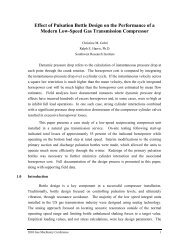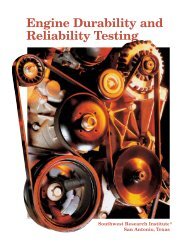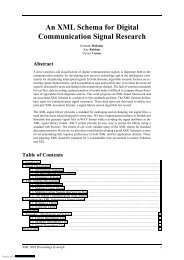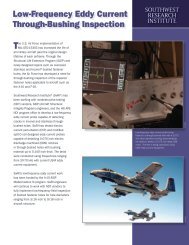Mechanical Engineering - Southwest Research Institute
Mechanical Engineering - Southwest Research Institute
Mechanical Engineering - Southwest Research Institute
Create successful ePaper yourself
Turn your PDF publications into a flip-book with our unique Google optimized e-Paper software.
<strong>Mechanical</strong> <strong>Engineering</strong><br />
SwRI engineers designed and built<br />
a novel wind turbine array system and<br />
evaluated a prototype in a large wind<br />
tunnel. We also conducted computational<br />
fluid dynamic simulations, validated by<br />
experimental data, to better understand<br />
the structure of the flow through the<br />
turbine array.<br />
1<br />
D017223<br />
D017222<br />
D016821-9191<br />
2 3 4<br />
D017252-2906<br />
D016700-4251<br />
D016864<br />
14
computational fluid dynamics • deep ocean simulations • fracture mechanics • flow measurement<br />
acoustics • probabilistic failure analysis • environmental testing • surface engineering & coatings<br />
telecommunications evaluations • structural mechanics • failure analysis • eddy current modeling<br />
thermal analysis • diagnostic software • corrosion analysis • nondestructive evaluation<br />
pipeline compression & measurement • biomechanics & biomaterials • magnetostrictive sensors<br />
life prediction • material integrity • terminal ballistics • guided wave inspection • aerodynamics<br />
Energy, aerospace and defense remain core areas of<br />
business at <strong>Southwest</strong> <strong>Research</strong> <strong>Institute</strong>, particularly<br />
in oil and gas production and transmission, renewable<br />
energy, military and commercial aircraft, manned<br />
submersibles, space hardware and military ground vehicle armaments.<br />
We are applying our expertise in sensors, fluids, materials,<br />
structures and mechanical engineering to help clients improve<br />
the safety, reliability, efficiency and life of their systems.<br />
In the energy arena, we are continuing compressor system<br />
design analysis for the natural gas pipeline industry initiated<br />
in the early 1950s. Recent technological breakthroughs at SwRI<br />
have resulted in more advanced compressor pulsation control<br />
methods, resulting in smoother running, more efficient and<br />
more reliable compressors (pulsations.swri.org).<br />
As offshore oil and gas production continues expanding<br />
into deeper waters, we continue to expand and improve our<br />
capabilities to address extreme temperatures and high pressures<br />
associated with these challenging environments. We have<br />
added sophisticated new experimental facilities to address<br />
corrosion fatigue, multiphase flow assurance and product<br />
assurance needs in deep-water environments.<br />
We also develop nondestructive sensor and data analysis<br />
techniques to inspect piping, nuclear reactors and other infrastructure<br />
for defects that could cause system failures (ndetech.<br />
swri.org).<br />
In addition to conventional energy production, we support<br />
the emerging wind turbine industry, helping improve the reliability<br />
and extend the operating life of gearboxes in large landbased<br />
installations (windpower.swri.org). The ability to store<br />
energy and match production with demand is key to broader<br />
deployment of renewable energy technologies, such as wind<br />
turbines and photo-voltaic solar cells. SwRI is developing<br />
computational methodologies to support designing materials<br />
to advance the power, efficiency and durability of batteries<br />
used in hybrid, plug-in hybrid and electric vehicles, as well as<br />
stationary power storage.<br />
In the defense arena, we are evaluating SwRI- and clientdeveloped<br />
armor concepts using ballistics testing and numerical<br />
simulations to help protect personnel from the devastating<br />
effects of improvised explosive devices. We also use probabilistic<br />
modeling and simulation techniques to evaluate various<br />
vehicle and occupant safety enhancements associated with<br />
collision, blast, fragment impact and rollover scenarios<br />
(compmech.swri.org).<br />
In the aerospace field, we continue working with the Air<br />
Force to help maintain the structural health and extend the<br />
service life of the T-38 advanced supersonic jet trainer and the<br />
A-10 weapons system (structuralintegrity.swri.org). We are<br />
helping the Army implement condition-based maintenance<br />
for its CH-47 helicopters, and we evaluated the static strength<br />
of an aircraft wing structure (verylightjet.swri.org).<br />
In 2009, we transitioned from design to fabrication of the<br />
next-generation deep ocean research submersible, successfully<br />
forming and joining the titanium hemispheres of the<br />
crew enclosure. The new submersible design will withstand<br />
depths of 6,500 meters, allowing access to 99 percent of the<br />
ocean floor.<br />
The <strong>Institute</strong> recently built a new crash test facility to<br />
perform full-scale vehicle crash testing on our grounds. The<br />
600-foot-long, 100-foot-wide crash pad provides a large,<br />
secluded, secure and unobstructed area for highway safety<br />
system and other large-scale evaluations.<br />
We developed a plasma enhanced magnetron sputtering<br />
process for applying erosion- and wear-resistant, super-hard<br />
nanocomposite coatings to components such as turbine<br />
blades and petroleum exploration equipment. In 2009, R&D<br />
Magazine selected the PEMS process as one of the 100 most<br />
significant technological advancements of the year (surface<br />
engineering.swri.org). v<br />
Visit mechmat.swri.org for more information or contact<br />
Vice President Danny Deffenbaugh at (210) 522-2384 or<br />
danny.deffenbaugh@swri.org.<br />
1. In 2009, our scientists developed carbon nanotube-based sensors<br />
capable of providing reliable, real-time detection of chemical and biological<br />
agents as well as physical changes in their surroundings. The<br />
sensors utilize high surface area designer biomolecules (inset) and/or<br />
chemoselective polymers and are promising candidates for real-world<br />
applications ranging from chemical warfare agent detection to in vitro<br />
medical diagnostics.<br />
2. SwRI engineers designed and fabricated the compressor for the<br />
International Space Station’s Sabatier system, which uses waste<br />
streams of carbon dioxide and hydrogen to manufacture water<br />
on-orbit.<br />
3. Our nondestructive evaluation specialists are developing inspection<br />
technologies to detect defects in buried cast iron pipes.<br />
4. Our computational specialists continue improving the Elastic-<br />
Plastic Impact Computations code used to simulate high-powered<br />
ballistic events. Recent advances allow EPIC to generate and characterize<br />
behind-armor debris fields produced in the wake of perforated<br />
targets, such as this debris field produced when a tungsten projectile<br />
perforated a steel target.<br />
15


